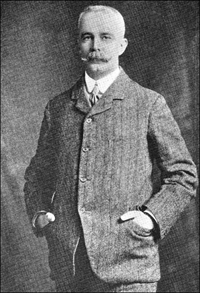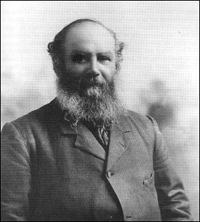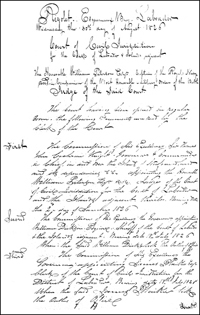Down North on the Labrador Circuit:
The Court of Civil Jurisdiction 1826 to 1833
by Nina Jane Goudie
“...the moral effect is greater than the amount of business done.” 1 1
Judge Sweetland, Labrador Circuit Court, 1863
Introduction
On Friday, September 22, 1829 southwest of Black Tickle at Seal Island Harbour four crewmen left the schooner Belinda and rowed to a freshwater runoff three miles away to refill their water casks. “On their return towards the vessel, the wind in an instant changed to the northwest and blew a perfect hurricane when unfortunately the boat upset and all on board perished.” 2 The schooner was hired each year to ferry officers of the Labrador Court from St. John's to communities along the south coast of Labrador. Such were the perils of day-to-day life on the Labrador judicial circuit. 2 The schooner was hired each year to ferry officers of the Labrador Court from St. John's to communities along the south coast of Labrador. Such were the perils of day-to-day life on the Labrador judicial circuit.
The court was a traveling one, located on board vessels which sailed from one community to another, handing down decisions on cases brought before the judge. It was but one of many forms of court present on the coast of Labrador during two centuries, either through naval commanders acting as governor's surrogates, resident surrogates appointed by the naval commander or governor, or, as in 1829, a judge of the Supreme Court of Newfoundland through annual visits of an itinerant court. All offered access to the English legal system — adapted to the realities of Newfoundland and Labrador — to fishermen, planters and merchants that frequented or lived along the coast of Labrador. Whether the court also resolved disputes involving indigenous people or foreign seasonal residents such as from the United States is unknown. But the court's presence had been inconsistent owing to a longstanding dispute between Quebec and Newfoundland over who exercised jurisdiction in Labrador, delays in implementing legislative change, and controversy over the cost versus benefit of providing legal services to a remote location with a small and geographically dispersed population. In 1830, the permanent population between Blanc Sablon and Sandwich Bay was estimated to be 2,000.
This study of Labrador is an initial legal history on the long coastline from Blanc Sablon to Sandwich Bay during eight years after the Supreme Court's arrival in 1826.3 The Labrador Court was established by the Judicature Act of 1824 “... for the Better Administration of Justice in Newfoundland” 4 which recognized the need in Newfoundland for a comprehensive legal system and provided for an extension of that system to Labrador. Once implemented, its structure was reminiscent of the surrogate system abolished in 1824, complementing rather than like the new Circuit Court model introduced on the rest of the island. As under the old surrogate system, the judge, William Paterson, was a captain of the former Royal Navy.5 But unlike the surrogate system, there were no resident governor's surrogates (surgeons, Anglican priests, and businessmen) to settle disputes in his absence during eight months of winter. Although the new system probably offered residents of Labrador less access to court appointed arbitrators Paterson promoted alternate dispute resolution at every opportunity. With a growing resident population and high levels of seasonal residency on account of fishing activity during the summer, speedy resolution of disputes would help maintain healthy community relationships — a key to survival in the North. Arbitrators were deferred to locally on an informal basis and the system proved an amicable and effective arrangement for all concerned.6 4 which recognized the need in Newfoundland for a comprehensive legal system and provided for an extension of that system to Labrador. Once implemented, its structure was reminiscent of the surrogate system abolished in 1824, complementing rather than like the new Circuit Court model introduced on the rest of the island. As under the old surrogate system, the judge, William Paterson, was a captain of the former Royal Navy.5 But unlike the surrogate system, there were no resident governor's surrogates (surgeons, Anglican priests, and businessmen) to settle disputes in his absence during eight months of winter. Although the new system probably offered residents of Labrador less access to court appointed arbitrators Paterson promoted alternate dispute resolution at every opportunity. With a growing resident population and high levels of seasonal residency on account of fishing activity during the summer, speedy resolution of disputes would help maintain healthy community relationships — a key to survival in the North. Arbitrators were deferred to locally on an informal basis and the system proved an amicable and effective arrangement for all concerned.6
W.G. Gosling
From William Gilbert Gosling: A Tribute (New York, The Guild Press, 1935).
 (395 kb). (395 kb).
|

|
Scholarly writings on the history of Labrador are few and far between.7 Today, as in the past, historians often reference Labrador but focus on Newfoundland, where interest is high and archival materials are available. The island of Newfoundland and the coast of Labrador each has their own lineage of historians. Newfoundland has John Reeves and Daniel Prowse; Labrador has William Gosling.8 All three were trailblazers. Their documented comprehensive histories have become benchmarks against which current and future histories will he measured.
Legal history is part of a modern day trend away from traditional histories that focused primarily on politics, wars and 'great' men.9 Cases brought before a court of law reflect the society in which it operated. They provide clues about personal relations, power struggles, community relations, work and wages, hard times, and the place of women. They reflect tensions between and among merchant, planter and fishermen. Each used the court system to protect their interests. Although Marquis believes that “legal history is one of the most neglected branches of social history in Canada,” 10 its study is well underway in Newfoundland. Years of postdoctoral research by Matthews, English and Bannister have provided a fine foundation down to 1833.11 English credits Reeves (1793) and Prowse (1895) as pioneers of Newfoundland legal history on the island. Neither studied Labrador. Gosling's Labrador offers the earliest perspectives. 10 its study is well underway in Newfoundland. Years of postdoctoral research by Matthews, English and Bannister have provided a fine foundation down to 1833.11 English credits Reeves (1793) and Prowse (1895) as pioneers of Newfoundland legal history on the island. Neither studied Labrador. Gosling's Labrador offers the earliest perspectives.

|
D.W. Prowse
Courtesy of the Provincial Archives of Newfoundland and Labrador (PANL), St. John's, Newfoundland.
 (223 kb). (223 kb).
|
This essay is based on original records of the Court of Civil Jurisdiction and the Court of Sessions for the Coast of Labrador (hereinafter referenced as the Labrador Court) from 1826 to 1833. These are housed at the Provincial Archives of Newfoundland and Labrador (PANL). Some primary documents were sourced through the Labrador Boundary Case records of 1927 housed at Memorial University in the Centre for Newfoundland Studies.12 We are fortunate that the English legal system required that meticulous records be kept of court proceedings. A clerk accompanied the court and recorded its day-to-day business in a thick volume; records were continued in the same volume year-to-year, as much as space would allow. They are faded now but the proceedings, conscientiously penned, are still readable.
Court of Civil Jurisdiction, Rigolet, 1826
From Blaikie, James and Simms, George, Records of the Court of Civil Jurisdiction, Labrador, 1826-1833, Provincial Archives of Newfoundland and labrador (PANL), GN5/5/G/1.
 (295 kb). (295 kb).
|

|
The law figures prominently in Labrador's past and affected its destiny on numerous occasions. The British gained Labrador from France by the Treaty of Paris in 1763. Before England could implement the decision to assign jurisdiction for Labrador to Newfoundland, Governor Murray in Quebec City gave Daniel Bayne and William Brymer a grant of private property on the Labrador coast. St. John's protested and a long legal battle ensued that precipitated the transfer of Labrador to Quebec in 1774.13 Gosling noted that although this transfer was made, it does not appear that the Province of Quebec ever exercised any jurisdiction on the debated coast. On the contrary, the Governors of Newfoundland, who were also the commanders of the fleet in those waters, continued to do so.14
Between 1774 and 1809 seasonal Newfoundland governors and the merchants of Conception Bay protested Quebec's jurisdiction. Governor Holloway in 1808 was concerned at his inability to prosecute offenders:
At present the most atrocious deeds may be committed, and the offenders go unpunished, irregularities being constantly practized [sic]; as also by the Americans who frequent the Coast, which I have no Authority to take Cognizance of although only to be detected by my Cruizers [sic]; Quebec being too remote for the Establishment of any Civil or other Authority.15
Lewis Anspach was of the opinion that Newfoundland “could more effectively than any other provide for the maintenance of order and the due administration of justice” in Labrador. Rothney concurred, noting that Newfoundland had much in common with Labrador such as their coastal population as well as a sole reliance on fish, fur and oil industries for their livelihood.16 Gosling remarked that,
Sir Charles Saunders pointed out that it would be impossible to go to Quebec to have disputes settled and that the loss of time and expense would ruin any fishery, whereas the Governor of Newfoundland could settle them in half an hour.17
The latter contention stretched the truth but it was widely recognized at the time that the Labrador fishery was carried on almost entirely by Newfoundland or West Country fishermen. In 1809, London repaired the damage and Labrador was returned to Newfoundland.18
|



